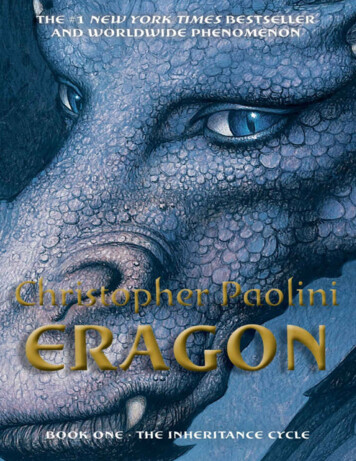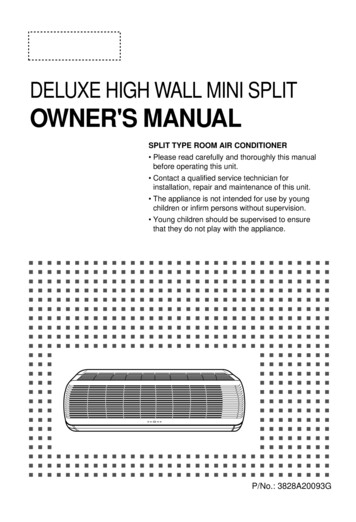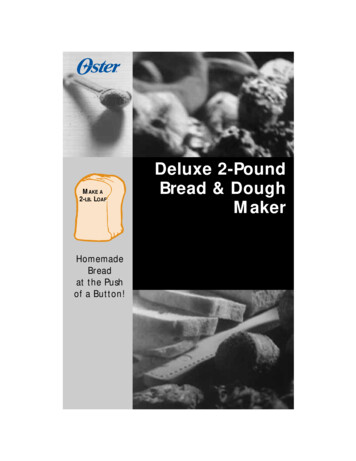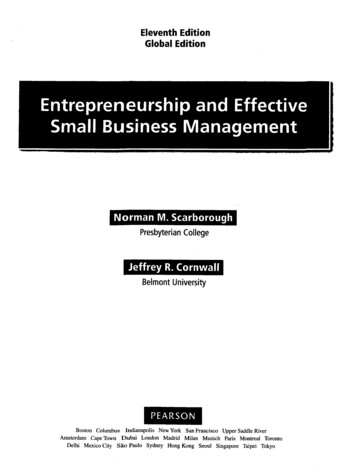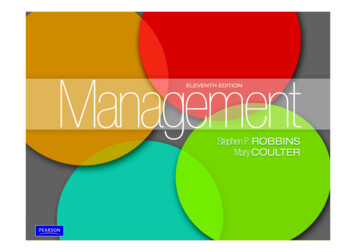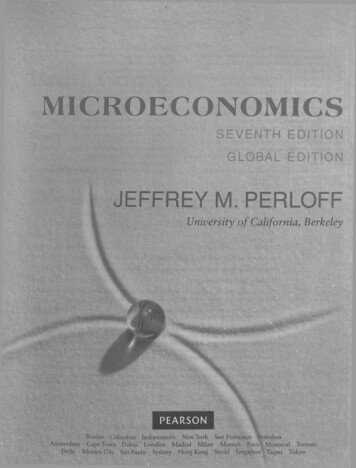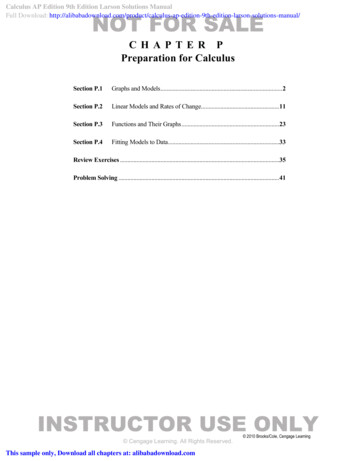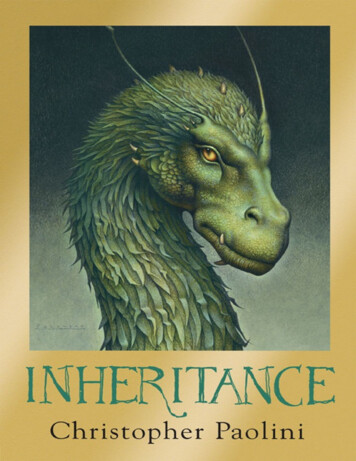
Transcription
THIS IS A BORZOI BOOK PUBLISHED BY ALFRED A. KNOPFThis is a work of fiction. Names, characters, places, and incidents either are theproduct of the author’s imagination or are used fictitiously. Any resemblance toactual persons, living or dead, events, or locales is entirely coincidental.Text copyright 2011 by Christopher PaoliniJacket art copyright 2011 by John Jude PalencarIllustrations on endpapers, this page, this page copyright 2002 by ChristopherPaoliniIllustrations on this page, this page copyright 2006 by Christopher PaoliniIllustrations on this page, this page copyright 2012 by Christopher PaoliniDragon poster art copyright 2012 by John Jude PalencarSword poster art copyright 2012 by Christopher PaoliniAll rights reserved. Published in the United States by Alfred A. Knopf, an imprintof Random House Children’s Books, a division of Random House, Inc., New York.Originally published in a slightly different form in the United States by Alfred A.Knopf, an imprint of Random House Children’s Books, New York, in 2011.Knopf, Borzoi Books, and the colophon are registered trademarks of RandomHouse, Inc.Visit us on the Web!Alagaesia.comrandomhouse.com/teensEducators and librarians, for a variety of teaching tools, visit us atRHTeachersLibrarians.comLibrary of Congress Cataloging-in-Publication DataPaolini, Christopher.Inheritance, or, The vault of souls / Christopher Paolini. —Deluxe ed.p. cm.—(The Inheritance cycle; bk. 4)“Originally published in a slightly different form by Alfred A. Knopf in
2011.”Summary: The young Dragon Rider Eragon must finally confront the evil kingGalbatorix to free Alagaesia from his rule once and for all.eISBN: 978-0-449-81321-8[1. Fantasy. 2. Dragons—Fiction.] I. Title. II. Title: Inheritance. III. Vault of souls.PZ7.P19535 In 2012 [Fic]—dc23 2012019421Deluxe EditionRandom House Children’s Books supports the First Amendment and celebrates theright to read.v3.1 r2
As always, this book is for my family.And also for the dreamers of dreams:the many artists, musicians, and storytellerswho have made this journey possible.
CoverTitle PageCopyrightDedicationA Note from ChristopherIn the Beginning: A History of Eragon, Eldest, and BrisingrInto the BreachHammerfallShadows on the HorizonKing CatAftermathMemories of the DeadWhat Is a Man?The Price of PowerRudely into the LightA Cradle SongNo Rest for the WearyDancing with SwordsNo Honor, No Glory, Only Blisters in Unfortunate PlacesMooneaterRumors and WritingAroughsDras-LeonaA Toss of the BonesMy Friend, My Enemy
A Flour Made of FlameDust and AshesInterregnumThardsvergûndnzmalThe Way of KnowingA Heart-to-HeartDiscoveryDecisionsUnder Hill and StoneTo Feed a GodInfidels on the LooseThe Tolling of the BellBlack-Shrike-Thorn-CaveHammer and HelmAnd the Walls FellBy the Banks of Lake LeonaThe Word of a RiderConclave of KingsA Maze Without EndFragments, Half-Seen and IndistinctQuestions UnansweredDepartureThe Torment of UncertaintyThe Hall of the SoothsayerOn the Wings of a DragonThe Sound of His Voice, the Touch of His HandSmall RebellionsA Crown of Ice and SnowBurrow GrubsAmid the Ruins
Snalglí for TwoThe Rock of KuthianAnd All the World a DreamA Question of CharacterThe Vault of SoulsLacuna, Part the FirstLacuna, Part the SecondReturnThe City of SorrowsWar CouncilA Matter of DutyFire in the NightOver the Wall and into the MawThe Storm BreaksThat Which Does Not Kill The Heart of the FrayThe Name of All NamesMuscle Against MetalThe Gift of KnowledgeDeath ThroesA Sea of NettlesHeir to the EmpireA Fitting EpitaphPieces on a BoardFírnenA Man of ConscienceBlood PricePromises, New and OldLeave-TakingOn the Origin of Names
Pronunciation Guide and GlossaryAcknowledgmentsLetter from Jeod
IKvetha Fricaya. Greetings, Friends.At last it’s done. The Inheritance cycle took me thirteen years tocomplete—1998 to 2011—far longer than I had expected. In fact,when I began Eragon, I never really thought I would continue thestory past the first volume.Why? Well, at fifteen, I wasn’t sure I could write the five hundredor so pages needed for a decent-sized book. (The most I’d ever writtenon one story was about five or six pages.) I didn’t know if I wanted tobe a professional writer or if that was even a possibility, although Icertainly loved telling stories. I had no idea where I would be or whatI would be doing in the next few years. (College was a real andimminent prospect at the time.) And I had far too many other things Iwanted to try my hand at to even begin to consider devoting myselfto one project in particular for years on end.What’s more, Eragon was only supposed to be a practice book—away for me to develop the skills I would need if I were ever toattempt a real book. Oh, I had tried writing several books beforeEragon, but I never got any further than those aforementioned five orsix pages. The problem was, I would get a cool idea, an idea thatmight serve as the kernel of a story but wasn’t a story in and of itself,and I would jump right into it without pausing to consider theunderlying structure. As a result, I had no idea where I was goingafter the first few pages, and back then I didn’t have the toolsnecessary to work out the plot on the fly.The first book I attempted was a pseudo-superhero story and is bestforgotten for the fluff it was. The second was a postapocalyptic novelthat actually showed some promise. But again, I had no feel for the
larger story, and I quickly abandoned it.Around the same time—this would be in 1997, I believe—I read abook called Jeremy Thatcher, Dragon Hatcher, by Bruce Coville. It’sabout a young man in our own world who goes into a beat-up oldcuriosity shop and ends up buying a stone that turns out to be adragon egg. Which, of course, hatches.For whatever reason, the idea of a young man finding a dragon egglodged in my head; I couldn’t seem to think about anything else. So, Istarted to write a story about just that.My first stab at Eragon was set here, in the real world. I didn’t writemore than a page before I realized it wasn’t what I wanted to do.Besides, it was too close to Bruce’s novel.My second stab was set in a more traditional fantasy world, and itcontained a number of elements you would recognize from thepublished version of Eragon, such as Arya sending the egg off to aforest, where Eragon finds it. It also contained substantial differences(the book started with a battle in a dungeon, Eragon was namedKevin, etc.). Although it was a stronger, more focused approach to thematerial, I still didn’t have a good feel for the world or the characters,and again, I stalled after five or six pages.At this point, I was getting pretty frustrated, and I realized that Ineeded to learn more about writing if I was ever to finish a full-lengthmanuscript.So, I stepped away from the story and spent the better part of 1998reading various books on how to construct plots, worlds, andcharacters. To my everlasting gratitude, my parents recognized myinterest and provided me with the resources I needed. If not for them,none of this would have been possible.During this period, I also read a number of extremely bad videogame tie-in novels, which by their very badness inspired me. Lookingat them, it was easy to feel that I could do better. In fact, I even setout to rewrite one of them from start to finish. However, I only put afew words on paper before it occurred to me that spending so muchtime on someone else’s work was rather pointless.It was then that I decided to put to use everything I had learned
that year and make a serious attempt at writing a book. But I didn’tjust jump into the first story that caught my imagination. No, thistime I was much more methodical about it. I outlined a step-by-stepprogression for myself that would, I hoped, lead me to where Iwanted to go.First, I spent a month or so creating a fantastical world and then,within it, plotting out an entire novel (which just so happened to stara half-elf princess named Arya)—all without any intention of writingsaid novel.It was just practice. Practice to see if I could even do such a thing.When I finished, I put aside both the world and the story. Then Isaid to myself, “All right, I know I can construct a plot. Now I’mgoing to see if I can plot out a whole trilogy—because all greatfantasies are trilogies—and then I’ll write the first book, again just aspractice. After that, I’ll go and write a real book.”That first book, of course, was Eragon. And writing it was one of themost exciting and transformative things I’ve ever done. As it sohappened, I couldn’t abandon Eragon after the first draft; I had puttoo much work into it, and practice book or not, I was determined tosee just how good I could make it.Every book in the Inheritance cycle has posed its own challenges:With Eragon, I had to learn the basics of grammar and storytelling.With Eldest, I had to prove both to myself and to the world thatEragon wasn’t a fluke. I also pushed myself technically in the secondbook in terms of my use of language, both real and invented; theemotions of the characters; and various structural elements. WithBrisingr, I carried those technical advances even further, and I had todeal with the unexpected need to divide the final book into twoseparate volumes in order to avoid publishing a book that was closeto two thousand pages. And with Inheritance, the task of ending astory (something I hadn’t really done before, despite having publishedthree books), the sheer length of the book, and a previouslyundiagnosed thyroid condition that left me barely able to move attimes all combined to test me to the very limits of my strength andability.
In a way, it was fitting that Eragon and his companions faced theirdarkest hour even as I did the same. The experience taught me manythings, the main one being the value of persistence. There were plentyof times I was tempted to walk away from this book and dosomething easier like moving large rocks by hand. Or painting alife-sized replica of the Sistine Chapel with a toothpick. But I stuckwith it because—outraged readers aside—I knew that I would neverforgive myself if I didn’t finish this journey.Though it was excruciatingly difficult at times, the Inheritancecycle has been an incredible and integral part of my life. Because ofit, I’ve had some amazing adventures and have gotten to meet lots ofinteresting people. Most importantly, it has allowed me to do what Ilove to do, which is tell stories. And for that I’m profoundly grateful.That said, if my fiction continues to mirror my life, I think I need towrite a comedy next.
IIAs for this particular volume, it’s special for a number of reasons.(Be forewarned, spoilers follow.)The book contains several pieces of new art—some of it mine, someof it cover artist John Jude Palencar’s—as well as my favoriteaddition: a letter from Jeod that takes place after the events of thisseries and serves as an epilogue. If you haven’t already, I recommendyou read Inheritance first, as the letter will otherwise give away majorplot points.Along with the art and the letter, I went back and changed the textin a handful of places. With any story this large, there are always afew details that slip past the author (and the editor, copy editors, testreaders, etc.). Therefore, when my publisher, Knopf, offered me thechance to revisit the book, I jumped at the opportunity.So, what have I changed?An astute reader noticed that Eragon’s sword failed to burst intoflame when he said its name during chapter thirty-six. A ratherembarrassing oversight on my part. This is now fixed.I slightly expanded the dialogue between Eragon and Arya near theend of chapter sixty, during their conversation on true names.In chapter sixty-one, I added a scene where Eragon again meets thewounded warrior from Brisingr who can see the light that illuminatesthe flesh of the world.In chapter sixty-four, a brief mention of Eragon’s enchantedfaelnirv. In chapter seventy-three, a few lines about Jeod and Saphira,and later on, a clarification of the paragraph dealing with the islandof Vroengard. And in chapter seventy-four, a mention of threeEldunarí staying behind in Du Weldenvarden for reasons explainedthereat.With the exception of the first and last changes, I take the view thatall of these things occurred in the original edition of Inheritance; Imerely failed to describe them.
IIIIt’s not an exaggeration to say that—so far at least—the Inheritancecycle has been my life’s work. I have every hope that someday I willexceed it, but for now, it’s my greatest accomplishment, and even if Inever do anything else, I can always point to the Inheritance cycleand say, “I did that!”Can you tell I’m proud of it?Still, it wasn’t easy to say goodbye to Eragon and Saphira—and allthe other characters—after spending so many years in their company.If, like me, you are sad to see them go, then I ask you to keep in mindthat the end of this book doesn’t mark the end of Alagaësia. Theworld goes on, whether or not I chronicle every moment of it. Dreamshave a life of their own, after all. Especially dreams of dragons.And yes, I have every intention of returning to Alagaësia at somepoint. (You may even be able to spot some of the openings I left forfuture books.) However, there are other stories that I want to tell first,stories that I hope you will enjoy just as much.In the meantime, turn the page and let me tell you of theadventures of Eragon Shadeslayer and Saphira Bjartskular as theymarch ever closer to the dark city of Urû’baen, where the dread king,Galbatorix, sits waiting upon his stolen throne. Atra esterní ono thelduin.Christopher PaoliniOctober 2012
In the beginning, there were dragons: proud, fierce, and independent.Their scales were like gems, and all who gazed upon them despaired,for their beauty was great and terrible.And they lived alone in the land of Alagaësia for ages uncounted.Then the god Helzvog made the stout and sturdy dwarves
Every book in the Inheritance cycle has posed its own challenges: With Eragon, I had to learn the basics of grammar and storytelling. With Eldest, I had to prove both to myself and to the world that Eragon wasn’t a fluke. I also pushed myself technically in the second book in terms of my use of language, both real and invented; the emotions of the characters; and various structural elements .


